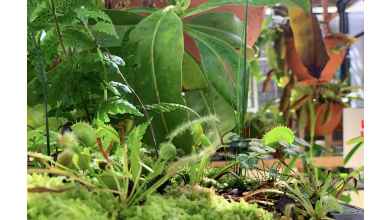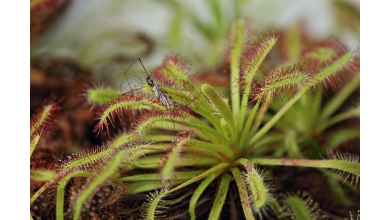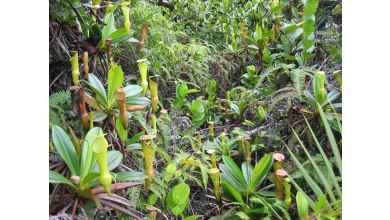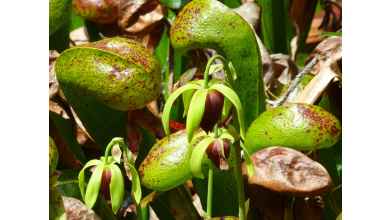Nepenthes Alata

Nepenthes Alata: The Fascinating World of the Pitcher Plant
Introduction
Nepenthes Alata, commonly known as the tropical pitcher plant, is a carnivorous plant that belongs to the Nepenthaceae family. This plant is a fascinating and unique organism, known for its ability to lure, trap, and digest insects and other small prey. In this article, we will explore the intriguing world of Nepenthes Alata, from its natural habitat to its unique adaptations, and how it has captured the attention of botanists and enthusiasts alike.
Natural Habitat
Nepenthes Alata is native to the Philippines, where it thrives in humid and tropical environments. This plant is found in a range of habitats, including rainforests, montane forests, and even disturbed areas like abandoned logging sites. Nepenthes Alata prefers to grow in nutrient-poor soil, and it often clings to the steep slopes of mountains, making it challenging to access and study.
Appearance and Anatomy
Nepenthes Alata is a climbing plant that can grow up to three metres long. It has long, narrow leaves that can range from green to reddish-brown in colour. However, the most striking feature of this plant is its modified leaves, which form into pitcher-shaped traps that can grow up to 30 cm in length. These traps are designed to attract and capture insects, which are then digested by the plant.
The trap of Nepenthes Alata is an intricate structure that consists of a slippery lip, a waxy zone, a digestive zone, and a lower, watery zone. The slippery lip is coated with a nectar-like substance that lures insects into the trap. Once inside, the insects slip and fall into the waxy zone, which makes it difficult for them to climb out. The digestive zone is lined with glands that secrete digestive enzymes that break down the insect's body. Finally, the lower, watery zone contains a pool of fluid that helps to drown the insect and dissolve its nutrients.
Adaptations
Nepenthes Alata has evolved several unique adaptations that allow it to survive in its challenging environment. One of these adaptations is its ability to capture and digest insects, which provides the plant with much-needed nutrients. The modified leaves of Nepenthes Alata have also adapted to withstand the harsh conditions of its habitat, such as strong winds, heavy rains, and poor soil quality.
Another adaptation of Nepenthes Alata is its ability to attract prey. The plant's traps are designed to mimic flowers, with bright colours and nectar-like secretions that lure insects into the trap. The slippery lip of the trap also makes it difficult for insects to escape once they have fallen in, ensuring that the plant gets its meal.
Cultivation
Nepenthes Alata is a popular plant among enthusiasts and collectors due to its unique appearance and adaptations. However, cultivating this plant can be challenging, as it requires specific conditions to thrive. Nepenthes Alata prefers high humidity, bright but indirect light, and soil that is low in nutrients. It is also important to ensure that the plant's trap is kept filled with water, as this is essential for the digestion of prey.
Conservation
Like many other species of plants, Nepenthes Alata is threatened by habitat loss and over-collection. Deforestation, mining, and agriculture have all contributed to the decline of this species, as well as the illegal collection of plants from the wild. To protect Nepenthes Alata and other carnivorous plants, it is essential to conserve their natural habitats and promote sustainable cultivation practices.
Conclusion
Nepenthes Alata is a fascinating and unique plant that has captured the attention of botanists and enthusiasts alike. Its modified leaves, pitcher-shaped traps, and unique adaptations make it a wonder of nature. While it may be challenging to cultivate and study, its importance in the ecosystem cannot be overstated. By promoting conservation efforts and sustainable cultivation practices, we can ensure that Nepenthes Alata and other carnivorous plants continue to thrive for generations to come.
FAQs
- Is Nepenthes Alata dangerous to humans?
- No, Nepenthes Alata is not dangerous to humans. While it is a carnivorous plant, it is designed to capture and digest small insects and other prey.
- Can Nepenthes Alata be grown indoors?
- Yes, Nepenthes Alata can be grown indoors, but it requires specific conditions to thrive, such as high humidity and bright but indirect light.
- How long does it take for Nepenthes Alata to digest its prey?
- The time it takes for Nepenthes Alata to digest its prey can vary depending on the size of the prey and the temperature of the environment. It can take anywhere from a few days to several weeks.
- What is the biggest threat to Nepenthes Alata?
- The biggest threat to Nepenthes Alata is habitat loss and over-collection. Deforestation, mining, and agriculture have all contributed to the decline of this species.
- Are there any other species of Nepenthes?
- Yes, there are over 100 species of Nepenthes, many of which are also carnivorous plants. These species can be found throughout Southeast Asia and parts of Australia.
Carnivorous Pitcher Plants May Lure Insects with Smell

Types of Carnivorous Plants

What Do Carnivorous Plants Eat?

Are There Any Carnivorous Plants in the UK?

How to Grow Venus Fly Trap from Seeds

Darlingtonia Californica Care Guide

